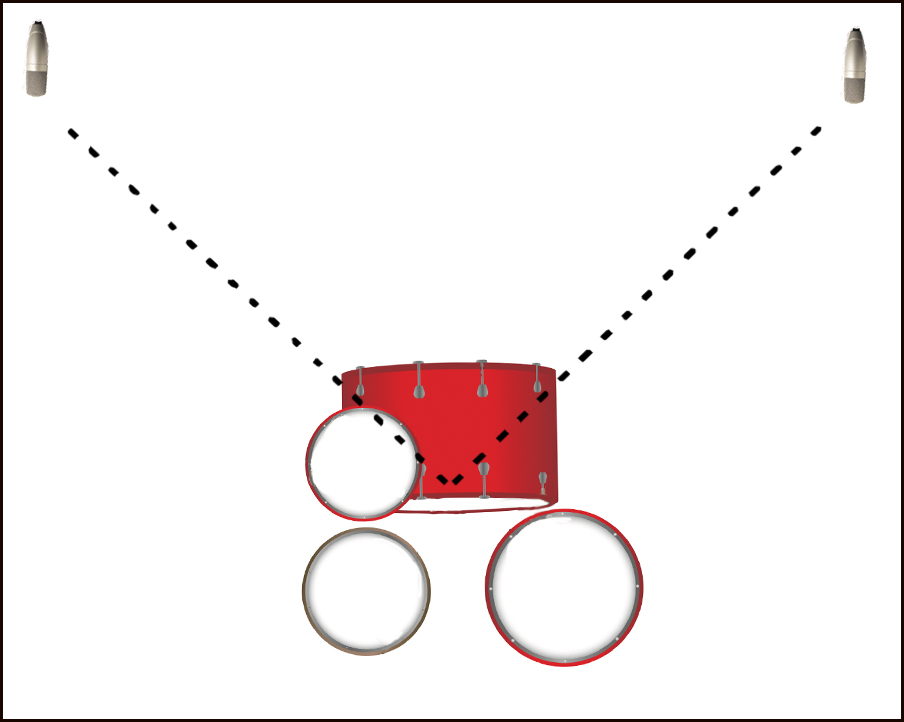It’s Questionable: Technology Corner: Room Mics (October 2013 Issue)
by John Emrich
A lot of people don’t understand how to capture a good room tone, and most people with a home studio don’t have the type of room that will have a sound worth capturing. A large, warm-sounding room is wonderful, but most drum rooms owned by drummers aren’t that; they serve more as practice spaces. That said, there is a concept that we can explore to give you the same type of effect as if you did have your drums set up in a nice, big room.
In a typical large studio with a lot of reflective surfaces, you would put room microphones at a considerable distance from the drums. When you listen to those channels by themselves, you’d hear less direct impact and a little smearing of the sound. Compare that with what you get from the overhead microphones, which should be capturing a well-balanced stereo image of the entire kit with plenty of attack and definition. Since you don’t have a big room to record your drums in, you’ll need to manipulate the sound of your room mics a bit in your digital audio workstation (DAW) to achieve a similar result.
Before we get to the processing, however, you have to decide which mics to use and where to put them. I recommend starting with a pair of Shure SM57s. These are inexpensive and will work well for this approach. Placement is going to be key. The positions of the two room microphones need to be at equal distance from that center point to achieve a well-balanced sound and to avoid phasing issues with the other microphones on the kit. You should also take into account the rest of the room and how it’s laid out. You want everything to be evenly spaced, and that includes the distance from the room mics to adjacent walls in your studio. Advertisement
Now let’s talk about how to process these room-mic channels. The first thing you want to do is add a compressor on them to smear the transients (initial hits) a bit and to level out the overall dynamic range. This is all done to taste, so have fun experimenting.
Next up is EQ. Consider what happens when you move farther away from a drumset. The biggest thing you’d notice is that the low end starts to fall away. You have to keep this in mind when processing your room mics, in order to simulate the natural acoustics of a drumset miked from a distance. I use EQ to roll off the low end a bit. Again, experiment to find the best frequency to start with.
Now apply some reverb to create the feeling that your drums are in a bigger and more reflective space.
The last item to address is the placement of the room-mic signals in relation to the other tracks. In a big studio, where the room mics are placed twenty to thirty feet from the drumset, the sound of the drums is going to reach the room mics slightly later than it reaches the close mics. That delay is a big part of what makes a drum recording sound “big.” To simulate this in your setup, all you need to do is highlight the room tracks in your DAW and slide them to the right a little bit. As you do this and listen back, you’ll notice a slap-back delay effect caused by the difference in timing between the tracks. Try different placements until you find one that works for your recording. Advertisement
I suggest starting with the room-channel faders turned all the way down and slowly bringing them up. If you have too much of this room sound in the mix, it will stick out like a sore thumb. Check out this audio clip to hear how it all meshes together. The first part of the audio clip is just the overheads. The second part is the room channels. The last section has the drum microphones soloed at first, and then I add the room mics.
Click below to listen or click here.
[audio:https://moderndrummer.com/wp-content/uploads/RoomMicsFinalMix.mp3|titles=It’s Questionable Technology Corner Room Mics]In case you’re wondering what gear I used to create the audio clips, here you go: Yamaha 01V96i digital mixing board, Cubase 7 DAW, Milab BDM-01 bass drum mic, Violet Design Wedge mic on snare, Violet Design Grand Pearl mic on pandeiro, Violet Design Flamingo Stereo overhead mic, Shure SM57 room mics, Dunnett Classic Ti drumset (14×20 bass drum, 6.5×13 snare, 8×10 and 14×14 toms), Gon Bops pandeiro, Crescent cymbals (20″ and 22″ Vintage rides, 18″ Eon crash, 14″ Eon hi-hats).



